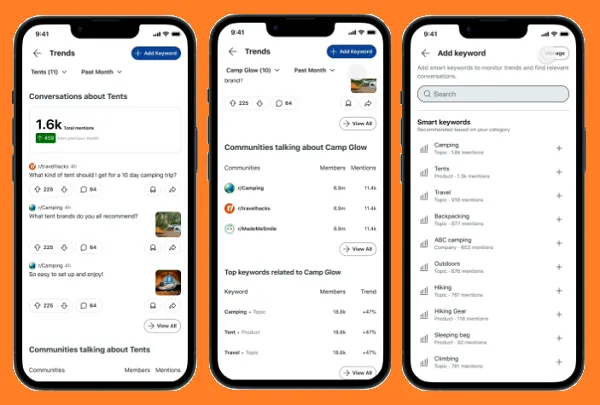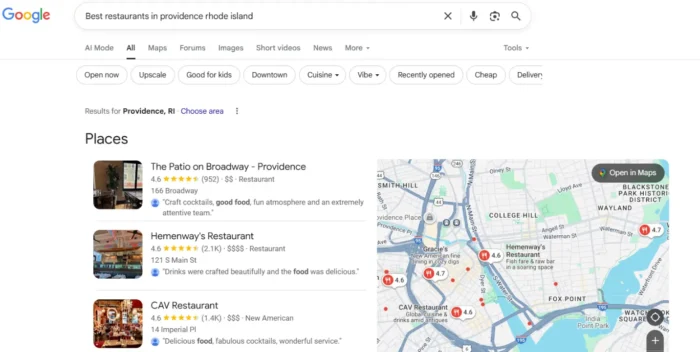The Beginner’s Guide to the 7 Chakras (What Are They, Their Meaning and Definition)
The post The Beginner’s Guide to the 7 Chakras (What Are They, Their Meaning and Definition) appeared first on The Yoga Nomads.
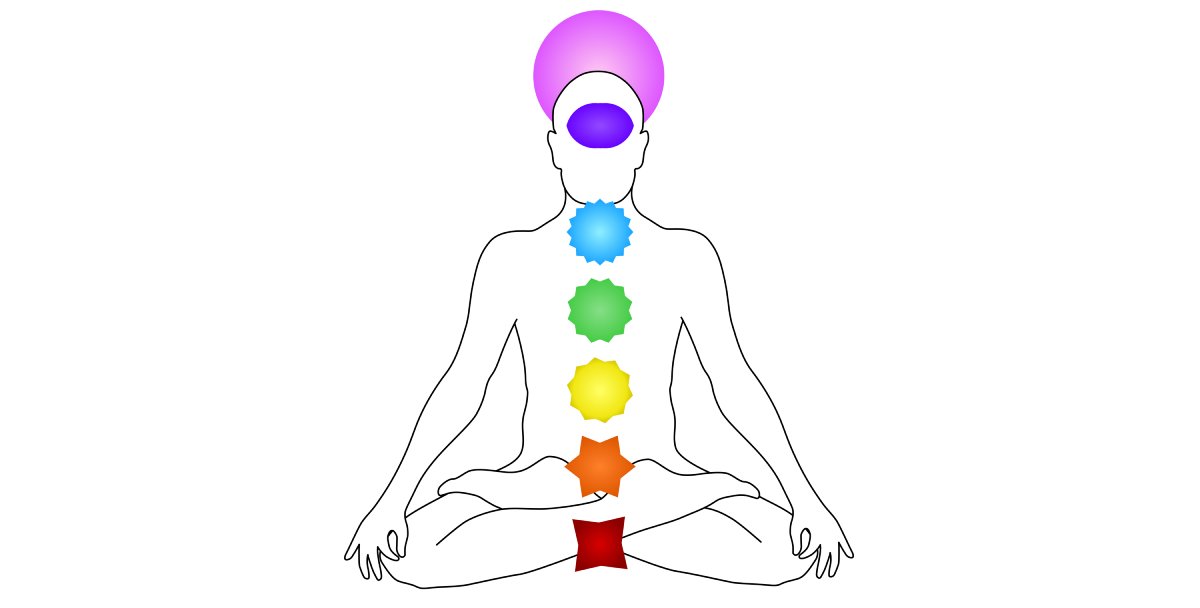
The chakras are something you’ve most likely heard mentioned multiple times before, whether in a yoga class, a guided meditation, or even a Reiki session. You might know that the chakras are related to our energetic bodies but do you understand what they are, what they do, and the differences between them?
If not, you’re in the right place. This article will explain what the elusive chakras are and how they may benefit your wellbeing. I’ll also discuss the history behind the chakras and their link to modern science. So make yourself a cup of tea and prepare to be amazed as we dive into our complex energetic bodies.
A quick intro to the Chakras
According to ancient yogic teachings, every human being has seven primary chakras, best described as energy centers. Chakra translates to “wheel” in Sanskrit. The energy of each center is said to turn and spin like a wheel. The seven chakras align along the spine, starting from the tailbone and ending at the crown of the head.
The chakras play a crucial role in our physical, mental, and emotional health, but each energy center has a specific function and governs a particular part of our being. Chakras are part of the subtle body, being neither solely physical nor solely spiritual. You cannot see or touch your chakras, and medical equipment like CT scanners cannot detect them, so there is no scientific evidence to prove they exist.
However, chakras are mentioned in detail in many ancient yogic and Hindu texts, such as the Bhagavad Gita. Along with these written teachings, knowledge of the chakras has been passed down verbally from teacher to student in India for centuries.
Today, the chakras are extremely popular among yoga practitioners, spiritual seekers, and New Age philosophers. What makes them so intriguing is that when balanced, they have the power to unite our minds, bodies, and spirits, creating a state of equilibrium. However, if one or more of our chakras are blocked, we can experience physical ailments, mental tension, or emotional pain.
The history of chakras
It is believed that the chakra system originated in India sometime between 1500 and 500 BC when it is mentioned in the oldest Hindu text, the Vedas. They appeared in Rg Veda over 29 times, spelled as ‘Cakra.’ In this text, they are referred to as ‘seven wheels’ and ‘rays of light.’
Other Hindu and Buddhist texts, such as the Upanishads, also spoke about the chakras. They revealed the chakras form a column along the spinal cord, from the tailbone to the top of the head. These texts also differentiated the subtle body from the physical body.
Interestingly, Hindi texts mention seven primary chakras, whereas Buddhist texts state there are four. Some Hindi texts also say there are 88,000 chakras altogether. However, information is only given on the seven primary ones.
The belief that you can awaken and energize the chakras first came from tantric teachings like Kundalini yoga. In Kundalini, various practices such as pranayama (breathwork), bandha activation, and mantra recitation are practiced to awaken energy in the first chakra (Muladhara). Once awakened, the life force moves up through the spine. It then passes each chakra until reaching the seventh one (Sahasrara), where profound spiritual transformation occurs.
The Chakra system remained Eastern philosophy until the 21st century, when New Age authors, like Anodea Judith, wrote about them. In her book, “Wheels of Life,” Judith expanded on the older texts and shared the knowledge in a more accessible and understandable way.
The chakras are a belief distinct from the historic Chinese system of meridians in acupuncture. Unlike the Chinese meridians, the chakras have a specific position in the energetic body but no definite nervous node or precise physical connection.
Chakra 101
Although some people believe there are thousands of chakras in the human body, we will focus on the seven primary energy centers. Read on for an overview of each chakra, its location, meaning, and associations.
Root Chakra (Muladhara)

Location: Base of spine
Responsible for: Stability, security, core needs
Color: Red
Element: Earth
The first chakra is the root chakra (Muladhara in Sanskrit), located at the base of the spine, near the tailbone. It governs our sense of safety and security and corresponds to our core needs like food, water, and shelter. It is also the part of us that gives us the driving force and energy to carry out our daily activities.
Each chakra has an associated color, which for the root chakra is red. Out of all the seven chakras, the Muladhara is the closest to the physical realm and most connected to our physical needs.
As the root chakra is our foundation, if this chakra is unbalanced, the others will likely be too. Thus, this is fundamentally the most essential chakra and the one you should work on before all others.
When in balance:
The root chakra corresponds to the earth element and is associated with planting roots. Therefore, when the root chakra is balanced, you feel grounded, safe, and at ease. However, the root chakra does not just govern physical security. It determines how secure and at home you feel in yourself. So with a balanced first chakra, you’ll be able to do things independently yet have no issues relying or depending on others.
When unbalanced:
If the root chakra energy is weak, you may feel unstable and unsafe and struggle to feel like you belong. Because it is also linked to financial security, you are more likely to have money worries if your root chakra is unbalanced. People with blocked root chakras typically feel weak, fearful, and insecure. They may struggle to trust others and the world around them and expect bad things to happen.
Sacral Chakra (Swadhisthana)
 35448441 – swadhistana sacral chakra symbol
35448441 – swadhistana sacral chakra symbolLocation: Below the navel
Responsible for: Regulating emotions, sexuality, creativity
Color: Orange
Element: Navel
The sacral chakra, or Swadhisthana in Sanskrit, is the second chakra in the chakra system and is located in the lower belly. Its precise location is between the belly button and the pubic bone. This energy center governs our emotions, creativity, pleasure, and sexuality.
The sacral chakra’s color is orange, and its element is water, representing emotions and flow. The sacral chakra determines our self-worth, particularly around sexuality and in relationships, as it’s located in the sex organ area. It is also closely linked to our senses. The stronger the energy of the second chakra, the more pleasure we are likely to experience in life.
When in balance:
People with a balanced sacral chakra can tap into their creative potential and freely express themselves. In addition, they feel emotionally stable with a healthy sex drive and connection to the senses. Someone with a balanced second chakra will feel joy and pleasure from things and experience passion, both romantically and with life pursuits.
When unbalanced:
An unbalanced sacral chakra typically results in the inability to control your emotions. and express yourself. As a result, you may lack self-worth around pleasure and thus, not allow yourself to experience joy in life.
People with blocked sacral chakras also struggle to find something in life they feel passionate about and lack romantic passion in relationships. Creative and sexual blocks are also common. An underactive second chakra can manifest physically as lower back pain and reproductive issues.
Solar Plexus Chakra (Manipura)
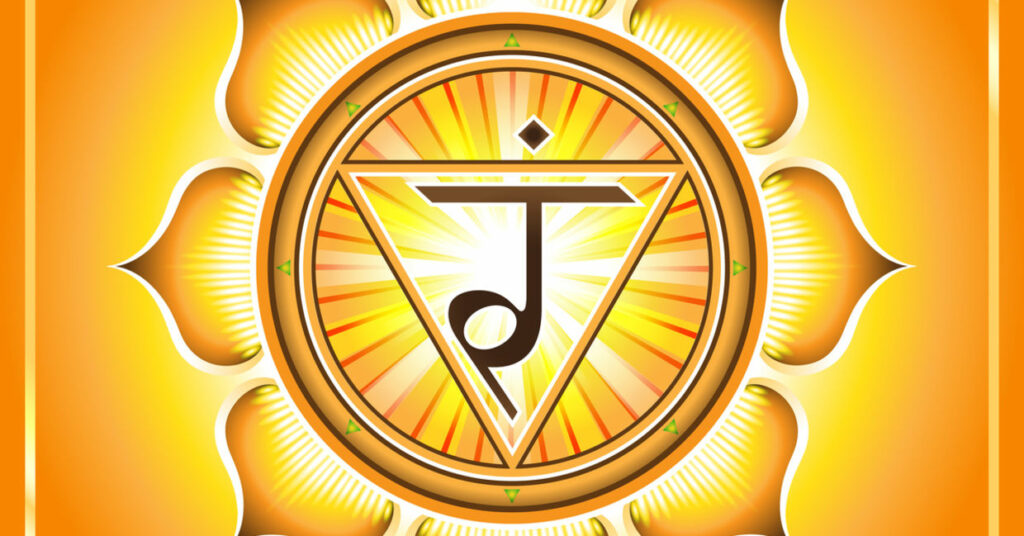
Location: Above the navel
Responsible for: Self-esteem, confidence, willpower, inner strength
Color: Yellow
Element: Fire
The Solar Plexus, or Manipura in Sanskrit, is the third chakra located just above the belly button in the upper abdomen. This center governs our confidence, willpower, and determination. In addition, the chakra allows us to take action and manifest our ideas into the physical world.
The Manipura’s color is red, and its element is fire, symbolizing the powerful, transformative energy this center contains. It’s closely linked to our self-esteem and our ability to bounce back from challenges. The third chakra is the home of our personal power, giving us our sense of identity and purpose in the world.
When in balance:
A balanced solar plexus chakra gives you the confidence, self-belief, and inner strength to turn your dreams into reality. You will feel courageous with no fear of taking risks, and you’ll be able to pick yourself up after knockbacks and failures. A person with a strong Manipura chakra also has a high level of energy and vitality.
When unbalanced:
If your Manipura chakra is blocked, you’ll lack confidence and self-belief, resulting in either holding yourself back and staying small or self-sabotaging. You may get ideas and start new projects but fail to follow them through. On a physical level, you’ll likely suffer fatigue and experience issues with digestion, as this chakra is linked to the digestive organs.
On the other hand, if your Manipura chakra is overactive, you may be controlling, power-hungry, self-centered, and competitive. As a result, you’ll likely get angry quickly and experience heartburn or ulcers.
Heart Chakra (Anahata)
 12931901 – the heart chakra
12931901 – the heart chakraLocation: Center of chest
Responsible for: Relationship with self and others, ability to give and feel love
Color: Green
Element: Air
The heart chakra (Anahata in Sanskrit) is the fourth chakra that bridges the lower three chakras (physical realm) with the upper three chakras (spiritual realm). The middle chakra is situated in the chest’s center, in line with the heart. It has a healing, calming energy linked to high vibration and positive qualities like love, compassion, understanding, and gratitude.
The heart chakra is associated with the healing color green and the air element, relating to touch, emotions, and expansion. Therefore, the condition of this chakra will determine the state of our relationships. So, the stronger it is, the more open we are to giving and receiving love.
When in balance:
A person with a balanced heart chakra freely feels and expresses love, joy, and gratitude. They can see their blessings and the beauty around them, and, as a result, they enjoy successful, happy relationships. They can feel empathy towards others and can forgive easily. Moreover, they fully love and accept themselves and can set healthy boundaries, resulting in the sense of harmony within.
When unbalanced:
Someone with a blocked heart chakra will find it difficult to feel love, compassion, and understanding for others and will find it equally challenging to accept love. In addition, outside of relationships, they will struggle to find things to be grateful for, as they have a tendency to see the bad in people and situations.
The root of a blocked chakra is a lack of self-love and acceptance, as a person cannot give love to others until they can love themselves. Because the Anahata chakra is associated with touch and air (prana), physical symptoms of a blocked heart chakra can be seen in the skin, hands, and lungs.
Throat Chakra (Vishuddha)

Location: Throat
Responsible for: Communication
Color: Light blue
Element: Space/Ether
The fifth chakra, Vishuddha, commonly known as the throat chakra, is situated at the base of the throat and the center of the larynx. As you may have already guessed, this energy center is related to our voice and communication. The throat chakra governs our ability to speak our truth and listen to others.
Vishuddha is the chakra that allows us to express ourselves verbally. It works closely with the second chakra (Swadhisthana). The sacral chakra helps you access your passion and creativity, and the throat chakra allows you to express it and share your ideas with others.
When in balance:
If your throat chakra is balanced, you’ll feel confident in public speaking and expressing your ideas and opinions. You’ll be able to clearly articulate your words and speak your truth without holding back. You’ll also be able to listen to others and participate in debates and heated conversations without turning them into arguments.
When unbalanced:
If there is a blockage in your fifth chakra, you’ll struggle to communicate with others and express yourself fully. Firstly, if the chakra is underactive, you might hold back in speaking your truth and instead say what you think will please others. In addition, you’ll likely detest public speaking and avoid sharing ideas in meetings.
On the other hand, if the chakra is overactive, you might find it challenging to listen to others and tend to gossip. People with overactive throat chakras are more likely to speak over others, shut them down, and not give them space to share their views.
Third-Eye Chakra (Ajna)
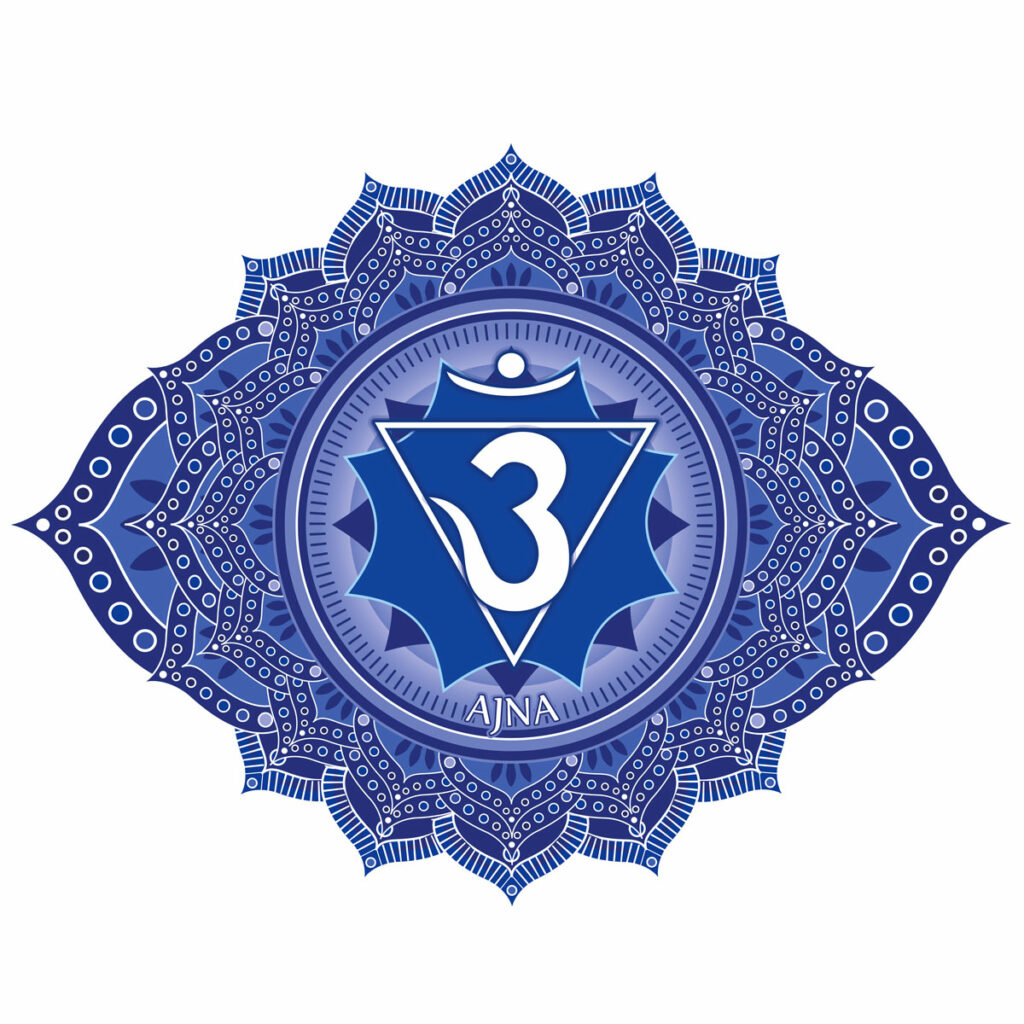
Location: Between the eyebrows
Responsible for: Intuition and imagination
Color: Indigo
Element: Light
As we travel upwards into the head, the energy shifts more into the spiritual realm and closer to divine consciousness, The third-eye chakra (called Ajna in Sanskrit) sits between the eyebrows. It is the first of the seven chakras not located on the spine, yet it is still in line with it.
The third-eye chakra is the center of our intuition. It governs our vision, both in terms of sight and imagination. Unfortunately, many people are too grounded in the physical realm to access this chakra, and it may remain closed for their entire life. However, those with an open sixth chakra will be able to access the power of their intuition.
When in balance:
If your third-eye chakra is open, you’ll be able to see the bigger picture in situations and will make decisions without the egos’ influence. You’ll be able to hear and follow guidance and affirmation from the universe through your intuition and have a strong imagination.
When unbalanced:
If your third-eye chakra is blocked, you’ll be overly attached to the external world and unable to connect to your inner wisdom. An Ajna chakra blockage can manifest physically as headaches and vision problems. It’s also possible for the third chakra to be overactive. If this happens, you’ll likely be cynical about beliefs different from yours and have trouble accepting reality.
Crown Chakra (Sahasrara)
 29428827 – the crown chakra
29428827 – the crown chakraLocation: Top of the head
Responsible for: Spiritual connection
Color: Purple
Element: Cosmic energy
The seventh and final chakra is the crown chakra, known in Sanskrit as Sahasrara. This chakra is the only one located off the body, sitting just above the top of the head. It is responsible for our connection to the divine and is the most challenging chakra to access.
The crown chakra is associated with enlightenment. If you are one of the lucky ones to open your crown chakra in this lifetime, it is said you will transcend the physical world. It’s only possible to open and balance this chakra if all six chakras below are balanced. However, once this chakra is open, it will help keep all the other chakras aligned.
The Sahasrara chakra is linked to the brain and nervous system, but as it is connected to all the other chakras, it can affect all organs in the body.
When in balance:
People with a balanced crown chakra have a strong spiritual connection to their higher selves. They have fully detached from their ego and external circumstances, and they experience bliss and divine consciousness.
When unbalanced:
A person with a blockage in the seventh chakra will seek happiness in the external world rather than within. They may also be narrow-minded, stubborn, and even dismiss the existence of spirituality. It is also possible for the crown chakra to become overactive. In this case, a person will lose touch with reality and struggle to function in the physical world.
How and why chakras get blocked

Blocked chakras can cause us much physical, mental, and emotional tension and prevent us from experiencing positive emotions like joy, love, pleasure, and safety. So what causes chakras to become blocked?
A chakra imbalance can be due to depleted energy (an underactive chakra) or too much energetic activity (an overactive chakra). These two types of blockages cause different problems.
If you have an underactive chakra, you’ll struggle to feel and express the particular qualities of that energy center. However, if it is overactive, those qualities become a dominant force in your life, turning into negative traits.
Generally, a chakra can become unbalanced if you experience too much physical or mental stress. The chakra that becomes blocked will depend on the specific stressful event. Here’s an example for each of the seven chakras:
Root – A blocked root chakra typically stems from childhood experiences. If someone did not feel safe growing up or moved around often, never feeling at home, they may struggle to find a sense of safety and security as an adult.Sacral – Second chakra blockages usually come from negative sexual experiences, addictions, or events that stifled a person’s creativity. Solar Plexus – The solar plexus (Manipura) chakra can become blocked if a person experiences a failure in life or receives criticism from others. Anything that strongly dents someone’s confidence can be enough to deplete the energy in the third chakra.Heart – Someone’s heart chakra may become blocked after a breakup, divorce, or death of a loved one. In situations where there is tremendous emotional pain, a person may decide not to get close to anyone again to protect themselves. However, rejecting all possibilities of future love and connection closes down the heart chakra. Throat – A person’s throat chakra may become blocked if someone ‘took their voice away’ by not allowing them to speak up or express themselves, mainly when growing up. Imbalances can also occur from being repeatedly ridiculed whenever voicing an opinion. Third-eye and Crown – Blockages in the upper two chakras work differently. It is said that these chakras only open up to those who seek a spiritual journey.How to unblock and realign chakras
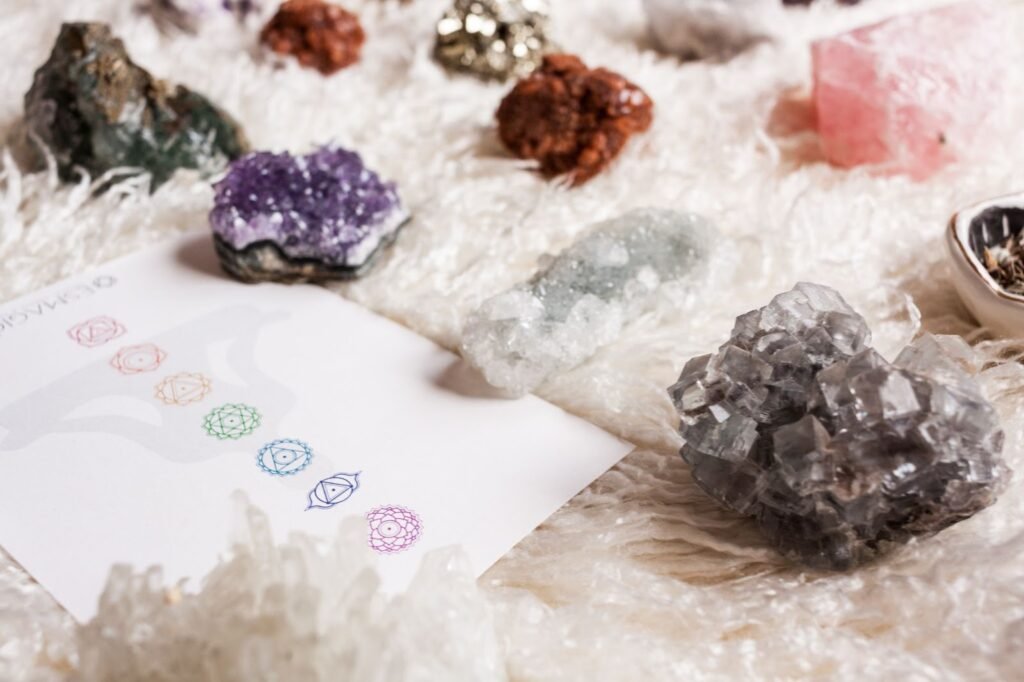
The good news is that it is possible to release blockages in chakras and bring them back to balance. However, it’s also important to note that there is no scientific evidence that chakras exist. The methods used to realign energy centers are “tried and tested” rather than scientifically proven.
Some of the most common ways to unblock and rebalance chakras are:
Yoga poses – Specific asanas can improve the energy flow in a particular chakra. Poses that stretch or compress the location of a chakra can be particularly beneficial. For example, backbends open the heart chakra as they expand the chest, and twists strengthen the solar plexus chakra as they apply compression to the upper abdomen. Visualization meditation – You can meditate on a chakra by visualizing the presence of energy in the chakra’s location. Visualization can also include the chakra’s color and element. For example, you can imagine an ocean of water for the sacral chakra. Foods – For centuries, yogis have believed that eating foods of the same color as a chakra will help bring it into balance. In addition, you should eat earthy food with a lower frequency to work on the lower chakras and lighter ‘airy’ foods with higher frequencies to open the upper chakras. Crystals – Like with foods, crystals that share the same color as a chakra may help rebalance it. You can work with crystals by holding them, wearing them on your body, or keeping them in your home. Every crystal has its unique benefits, so it’s best to research different ones first, then choose the one most suited to you.Mantras – According to ancient yogic teachings, each chakra has a seed mantra (vocal sound). Chanting this mantra is one way to align a chakra. You can learn the mantras by following this guided Seed Mantra Chanting MeditationSound healing – You can also work with a sound healing facilitator who will hold singing bowls over the chakra you need to balance. The vibration of the sound is said to help break up the chakra’s blockage. Breathwork – One way to work on realigning all your chakras at once is breathing exercises from Kundalini yoga. Pranayama increases your life force (prana) and promotes free-flowing energy in the entire subtle body.Specific activities for each chakra – Lastly, certain activities may help activate a particular energy center. For example, as the throat chakra is related to voice and communication, using your voice through singing or public speaking can help open this chakra. Or, if you want to open the upper two chakras, activities that use the brain, like meditation and reading spiritual texts, can help.Modern science and chakras
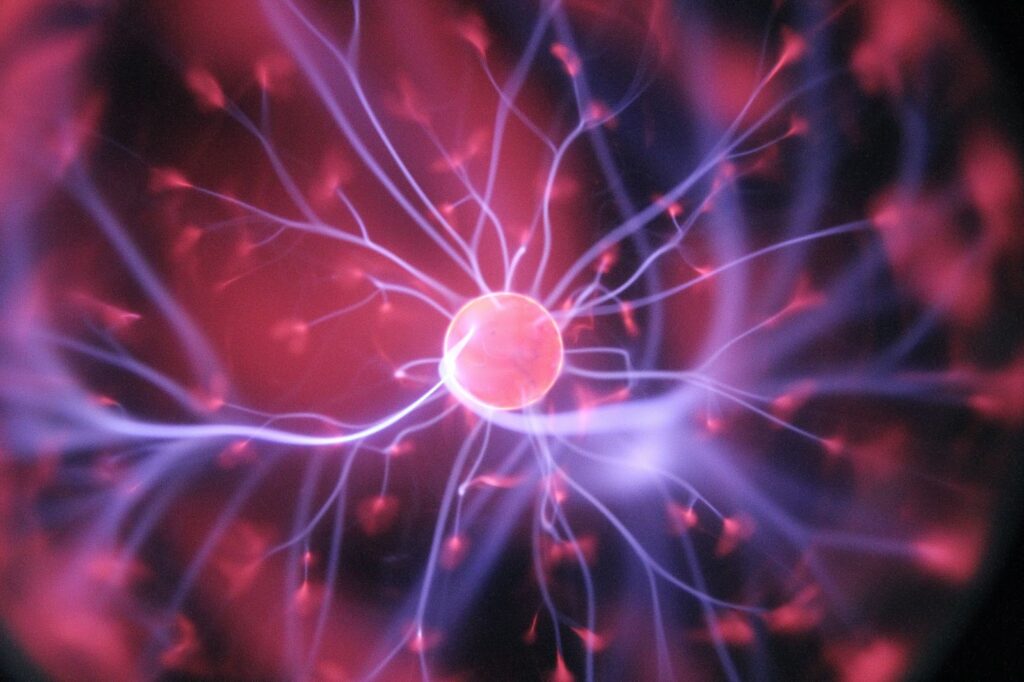
Unfortunately, modern science lacks the tools to confirm or deny the existence of the chakra energy system. No medical machine can detect the subtle body or the energy centers.
One of the modern beliefs about the chakra system is that each energy center correlates to a specific organ or bodily process. Moreover, it is said that the condition of the chakras determines the state of the associated organs. However, scientists have not been able to back this theory up with evidence.
The lack of scientific interest in the chakras could also play a role in the difficulty of proving their existence. In the 1970s, Valerie Hunt at UCLA tried to detect the chakras by using electrodes to measure energetic changes at each of the seven chakra locations. However, her approach did not work, and since then, there has been little effort from scientists to try again.
The lack of scientific evidence is not limited to the chakra system. Scientists have investigated other forms of energy healing, such as Reiki, and although their studies showed the practice to be effective, they could not understand the mechanism behind its success.
We should also bear in mind that it is difficult for many people in the west to see the mind and body as separate entities. Therefore, proving that nonphysical energy can interact with the physical world is likely still a long way off.
Final Thoughts
For some people, the chakra system is a fascinating phenomenon, and for others, it is ‘woo woo.’ However, even without scientific evidence, the amount of information we have on the chakra system today is thought-provoking, especially knowing it came from as far back as 500 BC.
You don’t have to readily accept everything you hear about the chakras, nor do you have to write it off completely. However, if you approach energy healing with an open mind, you can test out these theories yourself and possibly improve your health and wellbeing.

 KickT
KickT 








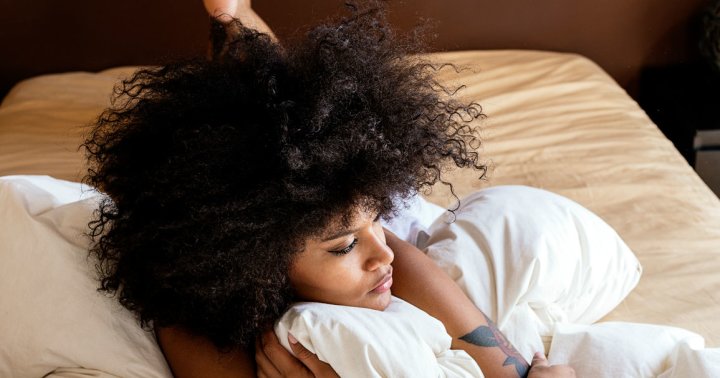
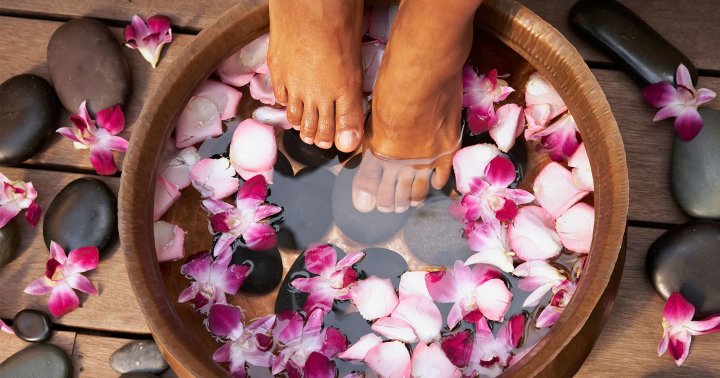


![Mondly Review: Excellent In Most Areas, But… [2021]](https://www.dumblittleman.com/wp-content/uploads/2021/08/hhhhh-1.png)













